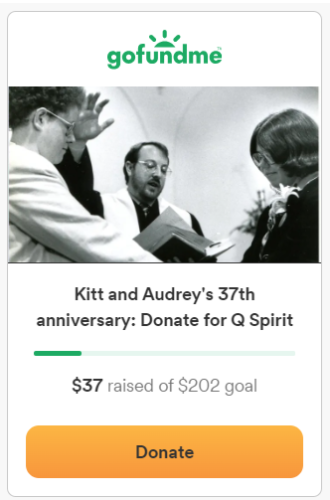Last Updated on April 26, 2024 by Kittredge Cherry

Celebrate Ascension Day with a painting of Christ embraced by a winged man in “Jesus Returns to God,” the most controversial image in Doug Blanchard’s gay Passion of Christ series. This year Ascension Day is May 9, 2024.
Christian tradition emphasizes that the resurrected Jesus ascends bodily — in the flesh — up into the clouds of heaven. Therefore it is appropriate for the Ascension painting to have a physical, erotic component, even though it upsets some viewers.
 The Feast of the Ascension commemorates Jesus rising to heaven. Blanchard, a gay New York artist, paints a queer version as part of his series about Jesus as a contemporary gay man in a modern city. The 24 paintings in “The Passion of Christ: A Gay Vision” are available as a blog series and book with reflections by Los Angeles lesbian author Kittredge Cherry. The art and reflections are also available as prints. The following reflection is an excerpt from the book.
The Feast of the Ascension commemorates Jesus rising to heaven. Blanchard, a gay New York artist, paints a queer version as part of his series about Jesus as a contemporary gay man in a modern city. The 24 paintings in “The Passion of Christ: A Gay Vision” are available as a blog series and book with reflections by Los Angeles lesbian author Kittredge Cherry. The art and reflections are also available as prints. The following reflection is an excerpt from the book.
_________________
“O that you would kiss me with the kisses of your mouth!” — Song of Songs 1:1
A winged man carries Jesus skyward in “Jesus Returns to God” from “The Passion of Christ: A Gay Vision,” a series of 24 paintings by Douglas Blanchard. The loving couple seems to dance in a mystical homoerotic union. Jesus, shirtless and wearing blue jeans, swoons in the arms of someone who appears to be an angel. But a close look reveals that they both have crucifixion wounds on their wrists. Jesus is embraced directly by God!
| Detail from “Jesus Returns to God” |
Two young men dance skyward in the mystical homoerotic union of “Jesus Returns to God”. Jesus, shirtless and wearing blue jeans, swoons in the arms of a winged dance partner who appears to be a hunky male angel. But they both have crucifixion wounds on their wrists. Jesus is embraced directly by God! The position of their arms suggests a ballroom dance, perhaps a waltz, with God’s hand planted firmly on Jesus’ bottom.
Beams of white light stream from God’s head in a bright sunburst, almost obliterating the blue sky. His wings look muscular, as if God must work hard to lift the dead weight of Jesus up from the earth. The wounds in Jesus’ wrists and feet were dark before, but now they glow like hot-pink jewels. Dissolving into white at the top, this is the lightest painting in Blanchard’s Passion series, contrasting with the pitch-black panel of Jesus Among the Dead. Now the misty clouds even spill over the frame on the lower left. The Bible and creeds make it clear where the dancing couple is headed. Soon Jesus will sit at the right hand of God.
“Jesus Returns to God” provides a gay vision of the Ascension, the transitional moment when the resurrected Christ left earth. Details vary, but all Biblical accounts agree that Jesus was with his followers when he was lifted up to heaven. Churches commemorate the event with the Feast of the Ascension forty days after Easter. Christian tradition emphasizes that the resurrected Jesus rose bodily up into the clouds of heaven. Mortal human flesh was made radiant by becoming part of God. Therefore it is appropriate for this image to have a physical, erotic component, even though some viewers find it disturbing.

Artist Doug Blanchard with his painting “Jesus Returns to God” in 2018
People tend to react strongly to this image. Some find it too sexual and recoil at the thought of “God’s hand on my butt.” (At least God has no body below the waist here!) Others welcome the painting because it removes the shame of sexuality, presenting erotic love as holy. Sacred same-sex kisses are rarer in art than gay bashings, so the most daring part of Blanchard’s Passion series occurs here after Jesus dies. Holy gay kisses also upset most people more than two men attacking each other. With this image Blanchard’s series truly becomes a “gay vision” as the title proclaims. There is no longer any doubt about whether Jesus was simply an ally of queer people. The full revelation of his gay sexual orientation does not happen in his lifetime, but is disclosed in the afterlife by Blanchard. Some people wish the series stopped right before this image. Others would prefer it started here.
Blanchard breaks new ground by combining the Ascension with the Christian concept of “mystical marriage” from a gay viewpoint, making this one of the most original paintings in the series. In Christian theology the Ascension serves to emphasize the reality of Jesus as both human and divine. It is seen as the consummation of God’s union with humanity. “Mystical marriage” is a separate Christian concept in which the love between God and people is compared to a human marriage, including the sexual ecstasy between bride and groom. Erotic union becomes a metaphor for union with God. This understanding dates back at least as far as Solomon’s Song of Songs in the Hebrew Scriptures.
God appears here for the first time in Blanchard’s Passion series. The artist paints God with some extraordinary attributes: He has wings, wounds, and the same face as Jesus. It is unusual to see a painting of God with wings, even though there are several Biblical references to humanity being protected or carried by God’s wings. The wings here might symbolize the presence of the Holy Spirit. Standard images show God and Jesus as father and son, but Blanchard makes them look like gay lovers or the same person in two places, further emphasizing his theme of God in solidarity with humanity. Usually only Jesus has crucifixion wounds, but here the all-powerful creator is also a wounded deity, injured by choosing mortality in order to help people.
The mystical marriage and Christ the Bridegroom are uncommon subjects in art history, but the Ascension has been painted many times over the centuries. Ascension images usually have two zones: a crowd of apostles watching from earth below and Jesus rising up into heaven above. Jesus is frequently shown with his right hand raised in a gesture of blessing. Sometimes just his feet are visible as he disappears into the clouds. Artists seldom depict only Jesus and God without the people below, as Blanchard does. A notable exception is “Ascension” by 20th-century surrealist Salvador Dali, which is dominated by the soles of Jesus’ feet as he flies upward.
Theologian Robert Shore-Goss proposes that this painting is “the hermeneutical key for interpreting the whole series” in an in-depth analysis of the gay Passion of Christ in his 2019 book “Unlocking Orthodoxies for Inclusive Theologies: Queer Alternatives.” He states, “The Ascended Christ now embraces the crucified Queer Body of Christ,” and he goes on to explain, “This station of Christ’s Ascension and his physical-spiritual embrace of a gay man symbolically asserts that the institutional church does not have ultimate control of Christ’s body and presence, for the Ascending Christ embraces the wounds of gay men, abjected with ecclesial hatred and cultural homophobia, carrying the marks of HIV, and the brutal hate crimes. The Ascending Christ incarnates the indecent outsider crucified by the church.”
While it fits neatly into the Passion series, “Jesus Returns to God” can also stand alone as a gay-affirming vision of ecstatic union with God. The mixed response to the painting raises questions about how artists can visually code Jesus as queer without being too literal. Conservative Christians have made many LGBT people think of Jesus as their enemy. How far should an artist go to counteract that? For some viewers, anything more than a subtle hint is too sexually explicit or reduces the mystery of Christ to a billboard. Others need a boldly out-and-proud Jesus to prove that God loves LGBT folk. Blanchard strikes a balance by showing Jesus as an ordinary man swept up in a homoerotic dance with God.
___
Top image credit: 22. Jesus Returns to God (from The Passion of Christ: A Gay Vision) by Douglas Blanchard
Collection of Clive Gardner
 New: “Jesus Returns to God” is available now on mugs, t-shirts, phone cases, notebooks, tote bags and a variety of other products at Pixels.com. So are all the other images in the gay Passion of Christ series.
New: “Jesus Returns to God” is available now on mugs, t-shirts, phone cases, notebooks, tote bags and a variety of other products at Pixels.com. So are all the other images in the gay Passion of Christ series.
___
Bible background
Song of Songs: “O that you would kiss me with the kisses of your mouth!”
___
This is part of the blog series “The Passion of Christ: A Gay Vision.”
The Passion series features 24 paintings by Douglas Blanchard, with text by Kittredge Cherry. It is also available as a book and prints and many more products.
This article was originally published in May 2017 and was most recently updated on April 26, 2024.
Scripture quotations are from Revised Standard Version of the Bible, copyright © 1946, 1952, and 1971 National Council of the Churches of Christ in the United States of America. Used by permission. All rights reserved.
Scripture quotations are also from the Inclusive Language Lectionary (Year C), copyright © 1985-88 National Council of the Churches of Christ in the United States of America.
Copyright © Kittredge Cherry. All rights reserved.
Qspirit.net presents the Jesus in Love Blog on LGBTQ spirituality.







I am very moved by this painting “Jesus returns to God”. I had not thought of the Ascension in the context of a marriage. How right it seems! And, as Mother Julian writes, God is both our father and our mother, therefore we can view this painting in the light of two men, two women or a man and a woman. Because I am certain that God experiences and values love in all these expressions, as we are all His children.